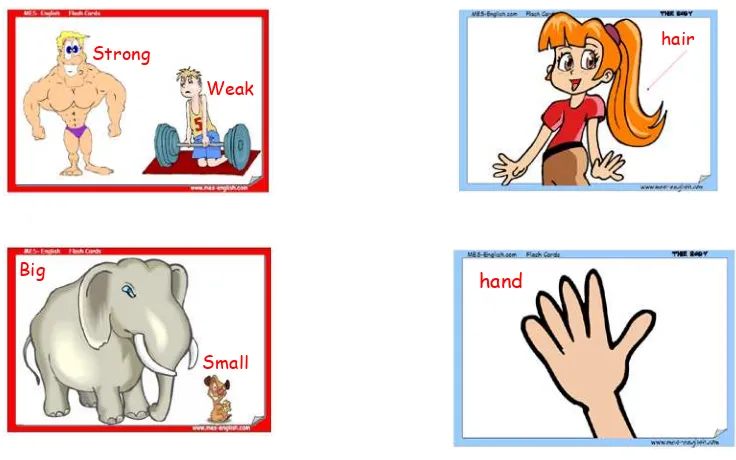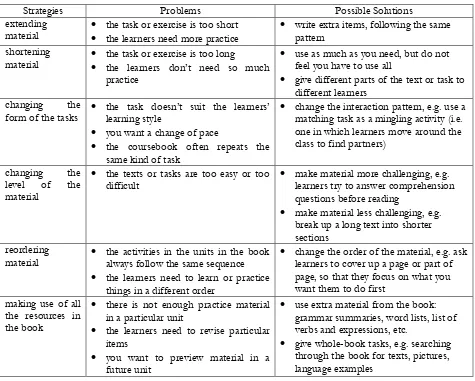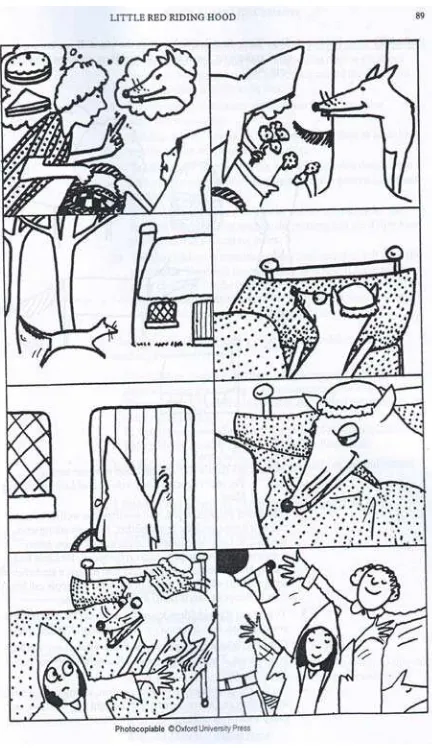Teaching English to Young Learners:
Materials are important resources for teachers in assisting pupils to learn English. In broader view, materials can be defined as anything which is used specifically with the intention of increasing pupil’s knowledge and experience of the language. Therefore materials may include textbooks (coursebooks), workbooks, story books, videos, cassettes, pictures, brochures, menus, interactive CDs, or other real-life artifacts, (Moon, 2003: 86). In choosing and selecting materials for the teaching practices, we need to have several considerations like whether we have to create the materials ourselves, how we can select appropriate materials for our pupils, how we can adapt the materials in assisting our learners in learning, and what the benefits are of either adapting or creating our own learning materials. The article then aims at discussing these considerations in choosing, selecting, or creating learning materials in the teaching of English for your learners.
Key words: learning materials, selecting, choosing, and adapting materials
Nowadays, there are wide varieties of readily-available materials in the stores like
coursebooks from all publishers and textbook writers, or picture cards and story books, or
interactive language activity CDs. Teachers can always select and choose one or more of
those materials and use them in their teaching practices. Some questions like whether the
materials are suitable for the pupils’ age level, interest, and cognitive development, whether
we have to create our own materials or simply buying them, or whether we can afford the
money and the time producing or buying the materials might arise. As well as questions
whether teachers should only use the materials from the coursebooks or how many
supplementary materials teachers can use in class to support the coursebook materials.
Moon (2003: 86) states that teachers’ conditions vary in at least three ways. Some
teachers have access to a range of coursebooks and supplementary materials to choose,
some have to follow a prescribed textbook, and some others do not use or do not have
coursebooks and produce their own materials. But the most, have access to at least one
coursebook. However, textbooks are made for general students and not specially
designed to meet certain needs, while in creating own materials, teachers face some
problems like the limitation of times, the lack of money, the problem in expertise and
experience, limited self confidence, and the limited source and reference materials.
Therefore, Moon (2003) also suggests several solutions to these common teachers’
problems;
1. Problem 1: lack of time in designing the materials
Involve your students in cutting, gluing, and in doing other practical jobs. They can
also make the illustration for teachers. This will be beneficial because students would
really feel that they are really involved in designing their learning materials and they
will also get the chance to use the TL. Furthermore teachers will have the benefits of
having more materials produced.
2. Problem 2: lack of cost involved
Working together with other teachers from the same school or even from the same
district would overcome this problem. Some cards or worksheets can be reused by
laminating them so they will last longer. Students can write the answers to the
questions in their own books.
3. Problem 3: lack of skills and expertise
If teachers have taught several years, then they will have enough experience and
expertise from their teaching practice. The key is to be confidence and to have the
willingness to try to design the materials. For those who have very little experience,
can always adapt materials and activities from the coursebook and modify them a
little.
4. Problem 4: lack of coursebook/reference books from which to get ideas
Getting together with other teachers from the same school or other teachers from
other schools locally in order to gain ideas is always a good one to try. Joining
beneficial. Last but not least, teachers can always get so many useful activities from
the internet by browsing several sites to get pictures or examples of lesson plan. Two
of the sites which provide very resourceful pictures, flashcards, and stickers are the
based arranged that it is easy for teachers to choose the pictures which suit their
needs. Here are some samples of the pictures that can be downloaded freely from
Figure 1, flashcards
Beside the two sites mentioned previously above, teachers can also access
materials and worksheets. The
teachers with materials that can be chosen to suit the students’ needs and level of
education. The materials range from vocabulary games like crosswords or word
search to reading and writing practices. It is worth the while to spend a little time to
browse and download some materials from this site.
5. Problem 5: limited self-confidence
Doing all the designing and adapting of materials regularly will gradually develop
teachers confidence in creating their own materials. Teachers can also ask peer
Strong
Weak
Big
Small
hair
The figure below is one of the examples of teachers-produced worksheet for listening
activity (copied from figure 29 in Brewster et.al., 2003)
b. Selecting Coursebook Materials
Spratt et.al (2005: 110) define coursebook materials as all the materials in a coursebook
package that we use in the classroom to present and practice language, and to develop
learner’s language skills. A coursebook package, they add, usually includes a student’s
book, a teacher’s book, and audio and/or video recordings. Often there is also a
workbook or an activity book included in the package. In selecting coursebook materials,
Spratt et.al (2005) suggest several questions that teachers can use as guidelines;
1. Is the material visually attractive? Is it visually clear (using different colors, different
fonts, headings, etc.)? Does the visual material help pupils to understand contexts
and meaning?
2. Is it well-organized? Can you and your students follow the logic of the material and
find your way around the page or the unit quickly and easily?
3. Is it culturally appropriate? Will the context(s) be familiar to learners?
4. Is it suitable for your learners’ age and their needs and interests?
5. Will the topic be motivating to suit age, gender, experience and personal interests of
your learners?
6. Is it at the right level? Does it provide a clear enough context and/or explanations
for the learners to understand new language?
When all or most of the answers are NO, Spratt et.al (2005: 110) suggest to replace the
coursebook materials with other materials which have the same focus/aim from another
book or resource, from the websites or supplementary materials. But if teachers can not
replace the coursebook with other books, teachers can always adapt the material, that is, to change it in some ways to make it suitable for the pupils. Spratt et.al. (2005) give
some ideas of how teachers can adapt materials to suit to particular teaching situation:
Table 1. Strategies, problems, and solutions in adapting materials
Strategies Problems Possible Solutions
extending material
• the task or exercise is too short • the learners need more practice
• write extra items, following the same pattern
shortening material
• the task or exercise is too long
• the learners don’t need so much
practice
• use as much as you need, but do not feel you have to use all
• give different parts of the text or task to different learners
changing the form of the tasks
• the task doesn’t suit the learners’ learning style
• you want a change of pace
• the coursebook often repeats the
same kind of task
• change the interaction pattern, e.g. use a matching task as a mingling activity (i.e. one in which learners move around the class to find partners)
changing the level of the material
• the texts or tasks are too easy or too difficult
• make material more challenging, e.g. learners try to answer comprehension questions before reading
• make material less challenging, e.g. break up a long text into shorter sections
reordering material
• the activities in the units in the book always follow the same sequence • the learners need to learn or practice
things in a different order
• change the order of the material, e.g. ask learners to cover up a page or part of page, so that they focus on what you want them to do first
making use of all the resources in the book
• there is not enough practice material in a particular unit
• the learners need to revise particular items
• you want to preview material in a future unit
• use extra material from the book: grammar summaries, word lists, list of verbs and expressions, etc.
• give whole-book tasks, e.g. searching through the book for texts, pictures, language examples
When adapting the materials, we need also to consider whether or not the leaving out of
one or two of the units create confusion on the students’ part, since coursebook is
sometimes the main resource of materials. Make sure our pupils are aware of what they
et. al. suggest teachers to provide additional activities for the materials, as shown in the
following table:
Table 2. Teachers’ strategy in personalizing materials
Coursebook provides: Teacher can provide additional:
situation/context warmer
pictures instructions
dialogues (conversations between two people) and texts
role-play
tasks and exercises homework tasks
Adapted from Spratt et.al. (2005).
When teachers plan to reorder the lesson, make sure that the organization of the
coursebook would allow that to happen, i.e. the lesson does not depend on the previous
lesson. Last but not least, teachers can always make the material more interesting by
using mime, gestures, and realia when presenting the materials.
Selecting and Using Supplementary Materials
Spratt et.al. (2005) define supplementary materials as books and other materials we
can use in addition to the coursebook. Supplementary materials include skill development
materials (grammar, vocabulary and phonology practice materials), collection of
communicative activities and teachers’ resource materials, authentic sources (newspaper or
magazine articles, video, etc), and free downloaded materials from the internet.
1. Skill development materials ( grammar, vocabulary and phonology practice
materials). Some materials that teachers can use to maintain their language
proficiency and deepen their insight knowledge on the practice of TEYL are:
a. How to Teach Pronunciation, by Gerald Kelly, published 2000 by Pearson Education
Ltd. This book is equipped by an audio CD that teachers can use to help them
improving their pronunciation skill.
b. Practical English Language Teaching: Young Learners, by Caroline T. Linse, published
2005 by McGraw Hill. This book will help teachers to understand the
methodology and some practical hints in TEYL. The book is also completed by
c. Teaching English to Children in Asia, David Paul, 2003 by Pearson Education North
Asia Ltd. This will help teachers to understand better TEYL practice in asian
context. This book is completed by applicable activities and games.
d. Cambridge Advanced Learner’s Dictionary Version 1,0. (2003). Cambridge University
Press. This digital dictionary helps teacher to check the pronunciation of some
words to avoid mispronunciation and misspelling.
e. A Handbook of Classroom English, Glyn S. Hughes, 1990 by Oxford University
Press. This book is a collection of practical and valuable classroom English to
enrich teachers’ proficiency. It is undeniable that teacher talks play a very
important role in pupil’s language development. Teacher talks are also authentic
language input for young learners, therefore teachers need to improve their
classroomese.
f.
publications which contain the current innovation and practices in teaching
English to young learners. Teachers can also share their experiences and learn
from other teacher’s experiences in dealing with young learners.
2. Collection of communicative activities and teachers’ resource materials
The growing concern on TEYL is also a rich land for publishers and book writers.
Therefore it is now very easy to get teachers resource books available everywhere. The
series of collection of Resource Books for Teachers published by Oxford University Press is
one very good example. The series range from collection of drama, games, art projects,
and stories. The books are also equipped by lesson plans which would be very useful for
teachers in developing their activities. Here are samples from Andrew Wright’s
Figure 3. Story script
Figure 5. Pictures for the story
Another valuable resource is 1000+ Pictures for Teachers to Copy by Andrew Wright
published by Longman. This book provides teachers with photocopiable pictures and
the practical clues on how to use those pictures. This book also gives practical
instruction to help teachers to draw their own figures. One other interesting resource
that teachers can use in the teaching is Function in English by Blundell et.al., 1992
published by Oxford University Press. This book is not designed as a material book for
teaching young learners, rather it is designed for language learners who needs to know
some English expressions used in different language functions. However, materials for
teaching learning are everywhere out there as long teachers creatively adapt them. In
using this book, then, teachers will need to select the simple expressions. Simple for the
young learners would be the expressions which consist only 2-4 words, easier to
pronounce, and which are very much commonly used in daily language.
3. Authentic sources (newspaper or magazine articles, video, etc)
There are plenty of authentic materials in our environment. Teachers can cut pictures
from magazines or newspapers and use them in their teaching practice. Shopping
catalogues from several department stores or clothing outlets can also make a rich source
of materials. VCDs and DVDs of animals wildlife from BBC or the National
Geographic are available everywhere. Teachers can ‘hunt’ and select those materials most
suitable for their needs.
4. Free downloaded materials from the internet.
The advancement of information technology like the internet allows teachers to get more
materials from the internet. Some free downloaded materials as mentioned earlier are
here and there in the websites. Here are some of the free downloaded materials that
teachers can use from the internet:
a. Pictures
Parts of the body. Retrieved December 4, 2009 from www.mes-english.com
b. Worksheet
There are invaluable sources of
worksheet that teachers can use to
enrich their collection. Teachers can
directly use the worksheets in the
classroom or adapt the worksheet to
suit the students’ level or age.
Therefore these worksheets may also
be the sources of inspiration when
teachers plan to design the
worksheets.
c. Samples of cards (invitation, birthday cards)
Internet provides thousands of examples of cards
such as greeting
cards, invitation
cards, congratulating
cards, thanking cards
and many more.
These cards can be
very valuable sources
of learning reading
and writing in English for children. These can also be
examples of learning English through projects because
designing cards involves students’ creativity to draw, color, paint, cut and glue, and
others.
d. Language (vocabulary) game
Weather word search language game.
e. video and audio materials
Internet is also a great source of video and audio materials. Free-accessed video site like
teaching. Youtube provides easily access short videos, kids songs, nursery rhymes, film
trailers, short cartoon movies, or self-made and home-made videos that can become
invaluable sources for an English classroom.
f. Stories
Stories make very good learning materials, particularly picture storybooks. Stories are full
of vocabularies as well as authentic English expressions that can be very meaningful for
children’s learning. Storybooks can be easily found in bookstores with and some can also
be freely downloaded from the internet. Here are some of the free downloaded picture
books:
Wilhelm, Oink! Moo! How do you do?: A book of animal sound
Wilhelm, A Cool Kid -Like Me
Closing
Learning materials for TEYL is everywhere. It can take the form of coursebook
materials or supplementary materials. Sometimes, certain material can not be fully exploited
in teaching otherwise the teachers can manipulate them maximally to help the pupils in
learning the target language. Therefore it is not the material itself that should be enriched but
also the teachers should be ‘well-equipped’ by appropriate and adequate teaching skills of the
teaching English to Young Learners.
References
Blundell, J. et al. (1992). Function in English. Oxford: Oxford University Press Brewster, J. et.al. (2003). The primary English teacher’s guide. Essex: Penguin Books Ltd. Cambridge Advanced Learner’s Dictionary Version 1,0. (2003). Cambridge University Press. Hughes, G. S. (1990). A handbook of classroom English. Oxford: Oxford University Press Kelly, G. (2000). How to teach pronunciation. Essex: Pearson Education Limited
Linse, C.T. (2005). Practical English language teaching: Young learners. New York: McGraw-Hill Companies Inc.
Moon, J. (2003). Children learn English. ……..: McMillan-Heinemann English Language Teaching
Paul, D. (2003). Teaching English to children in Asia. Hong Kong: Pearson Education North Asia Ltd.
Spratt, M., et. al. (2005). The TKT (Teaching Knowledge Test) course. Cambridge: Cambridge University Press



